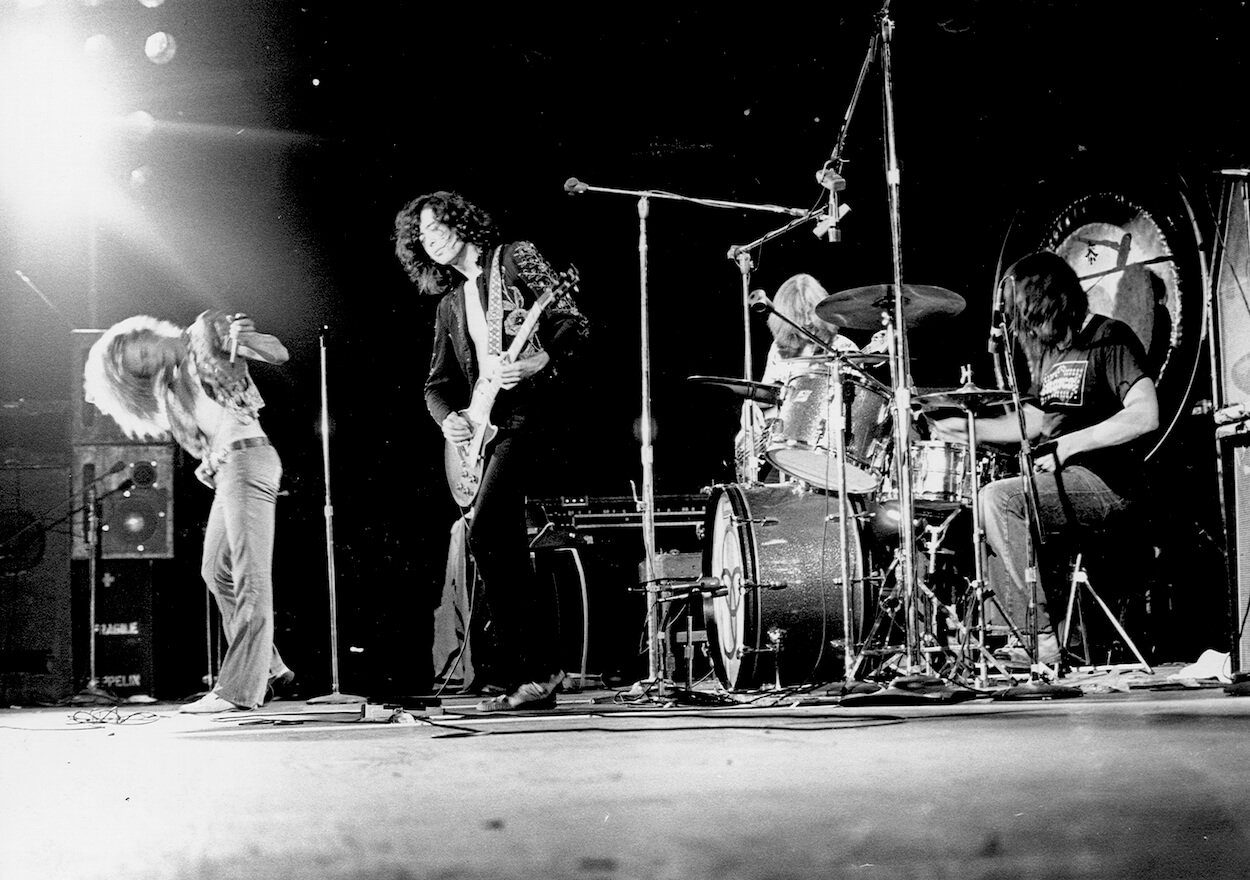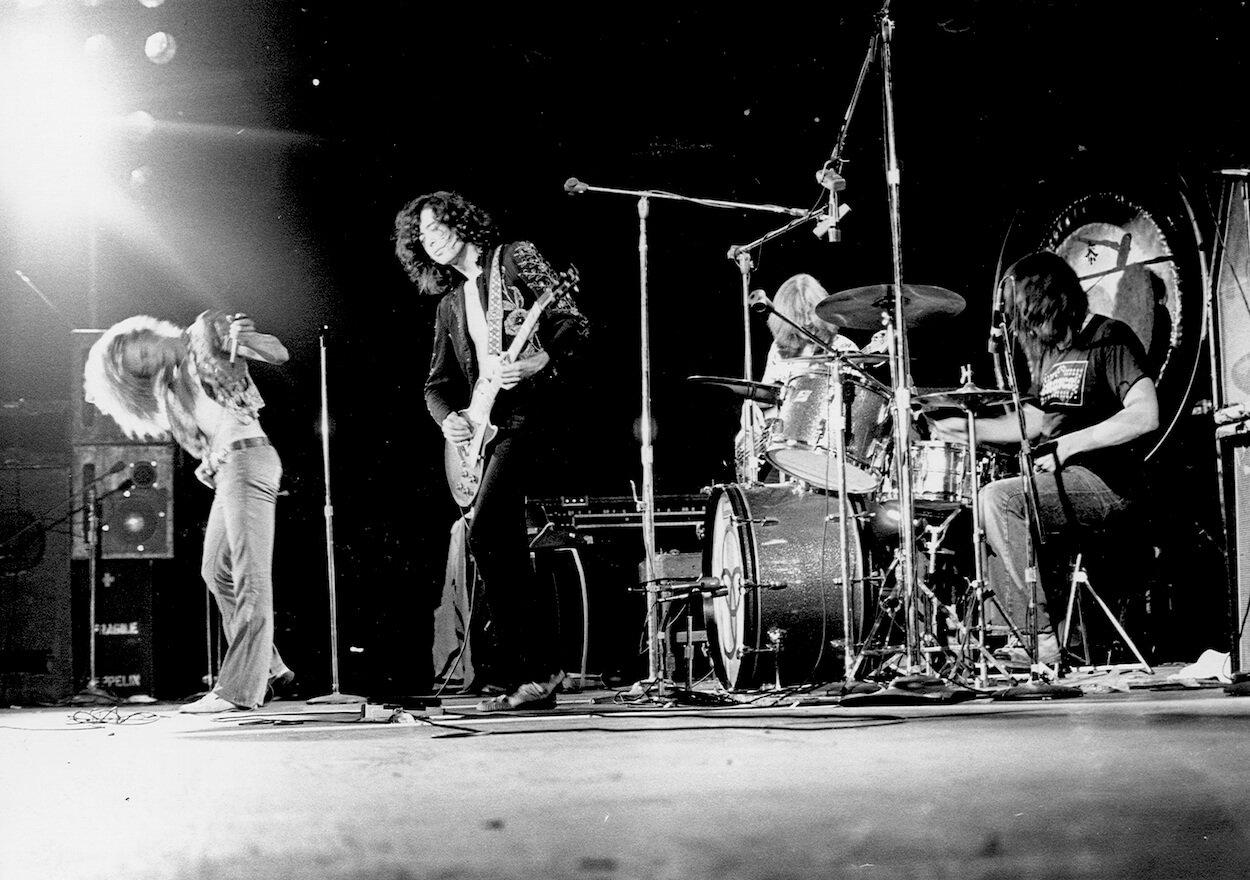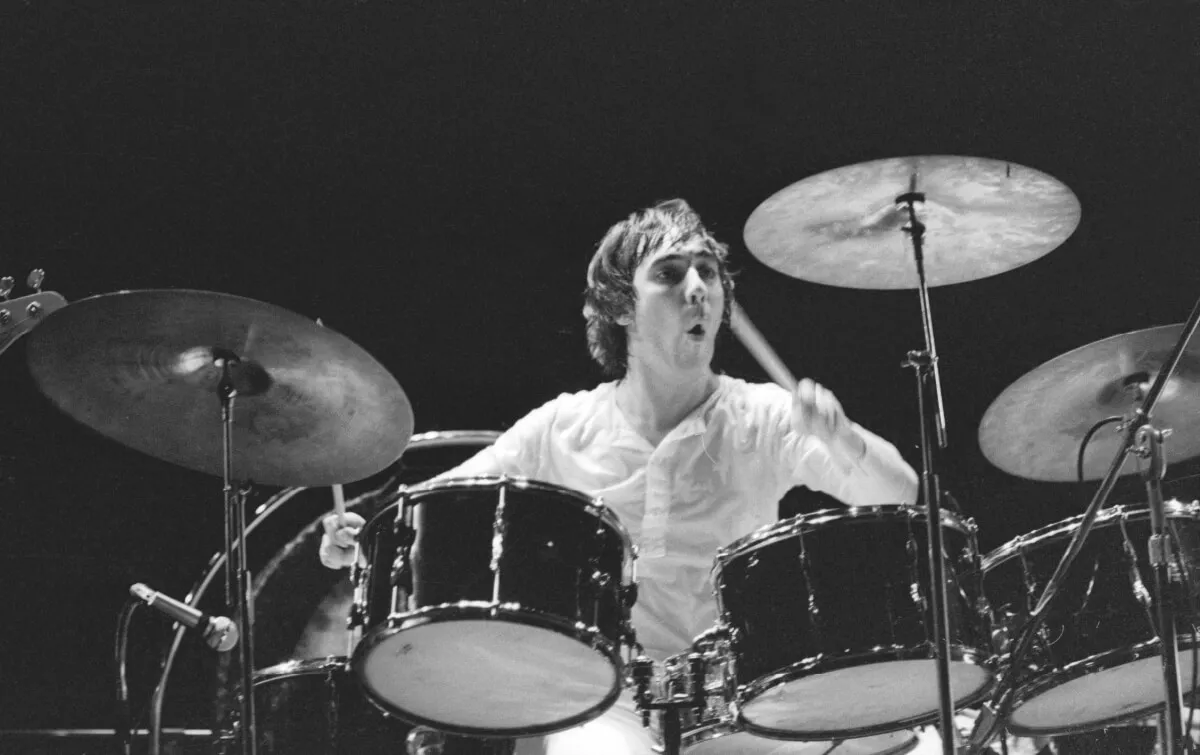
Led Zeppelin: ‘Houses of the Holy’ Songs, Ranked
Led Zeppelin hardly lived up to their name in the 1970s. A string of hit albums had them riding high as the biggest band in western music. Even shifting gears dramatically on 1973’s Houses of the Holy couldn’t slow them down. The album contains several notable hits, and we’re ranking them from worst to best.

8. ‘The Crunge’
Led Zeppelin’s homage to James Brown proved to be a bold experiment. It also happens to be the worst Houses of the Holy song.
It has a promising start. John Bonham flashes his drumming chops with a beat that falls somewhere between R&B and his jazz influences. John Paul Jones lays down a funky bass line that suits a James Brown tribute. But “The Crunge” falls apart when Jones’ synth line enters about a minute into the song. The mix pushes his synth to the forefront, covering up Plant’s nonsensical lyrics and Jimmy Page’s unspectacular guitar work.
They wanted to honor one of their greatest influences, but Led Zeppelin failed when attempting to play like the Godfather of Soul.
7. ‘D’yer Mak’er’
Another stylistic diversion and another one of Houses of the Holy’s worst songs. It’s one of Led Zeppelin’s most streamed songs on Spotify, but that doesn’t make it a classic.
“D’yer Mak’er” is a better sonic experiment than “The Crunge,” but their dancehall reggae can’t hold a candle to the rest of the tunes on the album. Zep bassist Jones hates the song because of Bonham’s lackluster drumming. Bonzo hated it, too. Half the band didn’t like “D’yer Mak’er,” and we totally get it. That’s why we’re placing it so far down our list.
6. ‘The Ocean’
It speaks to the overall strength of the Houses of the Holy that a solid song — Plant’s ode to the oceans of fans who watched Led Zeppelin in concert — rests so far down the list.
Page’s guitar tone seems to have teeth as it snarls out of the speakers, but that’s one of the few highlights for much of the song. Bonham plays a pedestrian drum beat, and Plant’s lyrics are nearly unintelligible.
The shift to jaunty pop with about a minute left is sudden yet satisfying and takes “The Ocean” across the finish line in style. Page’s solo is bright and sunny, and the nearly hidden “doo-ah” lyrics recall Zep’s early rock ‘n’ roll influences.
5. ‘Dancing Days’
One of Page’s most recognizable riffs also takes fans out of their comfort zone. The sliding riff sounds ominous thanks to an effect that plays the same notes in two slightly different pitches. Once listeners get familiar with Page’s main riff, he drops in a different sliding two-note couplet that sounds almost sinister.
If not for that guitar, “Dancing Days” could almost be mistaken for a west coast pop tune. Plant’s hippy-dippy lyrics, Jones’ synth line, and Bonham’s jaunty and uncomplicated beat counterbalance Page’s woozy guitar.
4. ‘No Quarter’
Houses of the Holy is Led Zeppelin’s sunniest album, both in terms of the music and production values. Yet the band that always worked across the musical spectrum couldn’t avoid exploring the darkness on “No Quarter.”
Jones’ baby prominently features his murky and menacing keyboard riffs and Page’s thick guitar sound that reminded him of water nymphs coming through the speakers. Plant’s howling and effects-altered vocals add to the mysterious aura of the song, and Bonham’s understated drumming perfectly anchors the song.
“No Quarter” is one of the best Houses of the Holy songs. The tune was so good that Page and Plant named their 1990s reunion project after Jones’ song — without telling him or inviting him to join, which was the ultimate slap in the face. Thankfully, the bassist didn’t hold a grudge and played with his bandmates again.
3. ‘Over the Hills and Far Away’
Ardent Led Zeppelin fans could make a case for any of the final three songs grabbing the No. 1 spot on our list of the best Houses of the Holy songs. “Over the Hills and Far Away” recalls Led Zeppelin III with its beautiful acoustic intro. The satisfying segue to hard rock at the 1:26 mark maintains the acoustic line while Page layers a complementary call-and-response electric riff on top.
The solo section starting at 2:32 leaves a little to be desired, though Page uses all of his fretboard and brings it to a lovely close with a stair-stepping riff. The quiet 12-string strumming closes the song much as it began. Led Zeppelin takes the listener on quite a ride in less than five minutes with “Over the Hills and Far Away.”
2. ‘The Rain Song’
It came to life because George Harrison critiqued Led Zeppelin for not playing enough ballads. Page then referenced George’s “Something” in what might be Zep’s best ballad.
Page’s delicate strumming starts “The Rain Song” in fine fashion. Jones’ Mellotron work stands in for a full string section, Plant is restrained, and Bonham sits out so long that his introduction to the song — with a delicate snare roll and cymbal crash — is fully felt. “The Rain Song” won’t be mistaken for “Stairway to Heaven” anytime soon, but the songs share similarities.
Harrison was wrong to call out Led Zeppelin over their lack of ballads. They had successfully gone quiet earlier in their career. (Maybe George didn’t listen to “Going to California” or “That’s the Way”). In any case, “The Rain Song” proved Zep had a soft side, and it’s one of the best Houses of the Holy tracks.
1. ‘The Song Remains the Same’
Led Zeppelin fans came to expect expert guitar work, pinpoint yet powerful drumming, propulsive bass, and strong vocals from the band. Page, Bonham, Jones, and Plant delivered on “The Song Remains the Same.” The celebratory opener is the best song on Houses of the Holy.
Page’s masterful 12-string playing opens the song, and he later adds satisfying solos that fit the song perfectly. Bonham’s busiest Houses drumming comes on “The Song Remains the Same,” but he never overpowers his bandmates. Jones’ bass underpins the whole thing, and Plant’s vocals keep up as Zep races through a song that takes the listener on a journey in less than 5:30.
Led Zeppelin’s fifth album achieved RIAA gold status in two weeks and eventually went platinum 11 times over, and it’s easy to see why. Despite two massive missteps, the best Houses of the Holy songs rank among some of the band’s best work.
For more on the entertainment world and exclusive interviews, subscribe to Showbiz Cheat Sheet’s YouTube channel.


